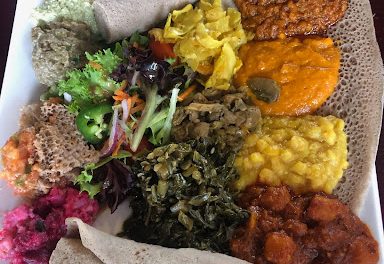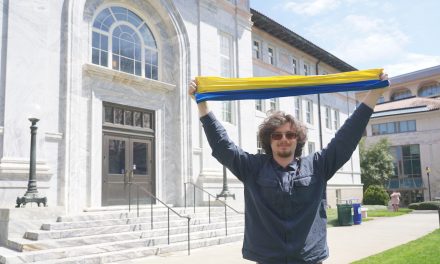Although she was born with only six fingers in total and asymmetrical arms, Rosemarie Garland-Thomson admitted it took her decades to think of herself as disabled. Growing up with a stable and loving family, Garland-Thomson had a different childhood than many other disabled children of her generation.
“I was able to go to school,” said Garland-Thomson, an English professor and co-director of the Emory College Disabilities Studies Initiative. “When I was growing up, people with disabilities went to special schools.”
She was excluded from certain gym and music classes because of her disabilities and, at the time, there was no concept of adaptive education. But she was social and enjoyed reading and writing.
It was around the age of 40 — when Garland-Thomson learned more about the women’s and civil rights movements — that she began to notice similarly unfair treatment in her own life.
“I [transferred] the logic of the women’s movement and the black civil rights movement [over to] what I was understanding as disability,” Garland-Thomson said.
She then learned of the disability rights movement, started to identify as disabled and became involved in the disabled community.
Garland-Thomson, also a disability bioethicist, explores controversial questions on a daily basis — questions that pertain to prenatal screening, who we bring into this world and how society treats certain members. She works to understand the morality involved in answering questions about living with disabilities. She often goes from teaching courses at Emory to flying across the country in a matter of days.
Garland-Thomson most recently attended Disability as Spectacle, an annual conference held at the University of California, Los Angeles, where she gave the keynote address on eugenics history in the United States. The conference featured numerous works of art focusing on disabilities by artists such as Sandie Yi and A. Laura Brody. The gallery included soft-toned murals of bone fragments and wheelchairs made into art pieces, including “Jazzy Peacock Scooter” by Brody, which depicted a stuffed peacock’s feathered blue body attached to the back of a wheelchair.
At conferences like that, Garland-Thomson talks about her own work in the fields of disability theory and bioethics, which she explores in part through literature.
“A lot of what I’ve been doing as a literature professor is [telling and analyzing] stories about living with a disability,” Garland-Thomson said. “Literature has a great deal to tell us about ethics around disability, as does art.”
Garland-Thomson is currently working on a book, Habitable Worlds: Disability, Technology, and Eugenics, in which she explores the concept of worldbuilding and how, through certain societal constructions, society is made uninhabitable for certain people such as people of color, members of the LGBT community and members of the disabled community. As a disability bioethicist, she tries to bring ethical issues surrounding disability into the academic discourse and plans to discuss how the world can not only accommodate but welcome a wider spectrum of people.
Garland-Thomson currently explores medicinal ethics and disability. She works with narrative and life-writing, the act of writing about one’s life and experiences, to educate others about the ethics behind how we treat certain people. That work manifests itself in her undergraduate life-writing class at Emory called “Wounded Storytellers.” In class, her students examine a variety of narratives exploring physical and mental distress. Garland-Thomson has influenced her current teaching assistant, Samantha VanHorn, a second-year Ph.D. student in the Women’s, Gender and Sexuality Studies department and doctoral certificate student in bioethics in several ways.
“I know Garland-Thomson in four capacities: as a friend, professor, classmate and mentor,” VanHorn said. “[She] is brilliant, accessible and approachable … it’s evident that she enjoys her time teaching.”
Garland-Thomson said her favorite part about the “Wounded Storytellers” class is the final project, for which students present on aspects of their own lives and utilize the skills they have developed in life-writing. Garland-Thomson described those projects as “moving,” recounting how students used those projects in past semesters to report on themselves or someone they love, usually making for powerful final projects.
VanHorn and Garland-Thomson view these projects as integral to the students’ overall experiences in the life-writing-oriented classroom.
“[Garland-Thomson and I] both believe our students have their own stories to tell,” VanHorn said.
Garland-Thomson said she feels grateful to be capable of making such a profound impact on other people.
“I have written about [disability] narratives in ways that have — and people have said this to me — changed the way people think about themselves and other people,” Garland-Thomson said.
In August 2016, The New York Times published Garland-Thomson’s op-ed “Becoming Disabled,” the inaugural piece for a weekly series in the Times called “Disability,” in which art, essays and opinion pieces are written by and about people living with disabilities. As the first author in the series, Garland-Thomson received a number of emails from readers expressing their gratitude. She said that she believes she affects people in such a powerful way by changing the way they think about disabilities present in themselves, loved ones or both.
“It’s that reconceptualization that has profound meaning for people,” Garland-Thomson said. “People have come to me and said ‘I’ve never thought about it that way.’”






